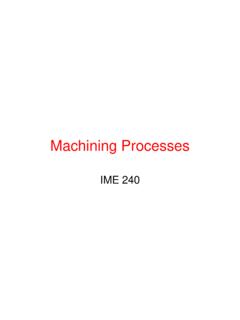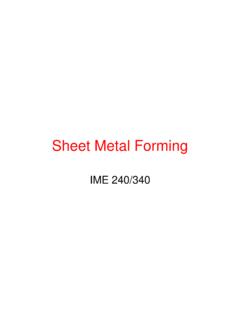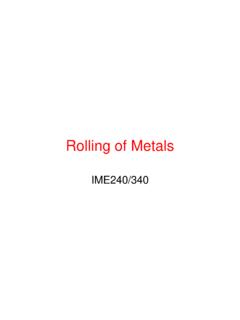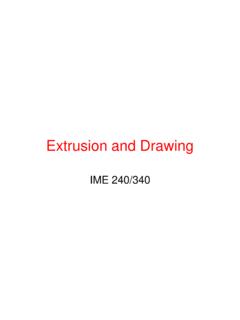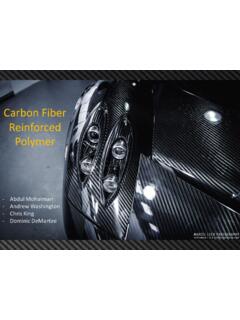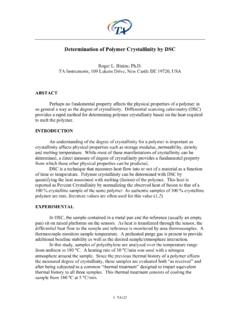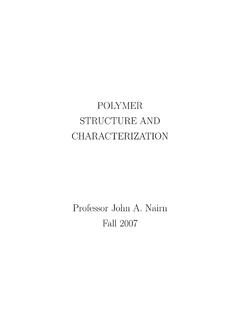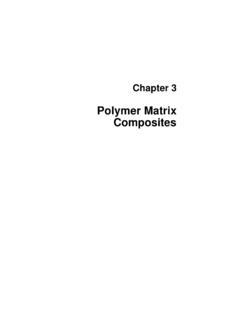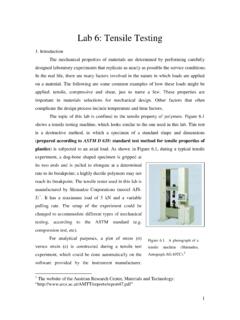Transcription of Polymer Processing - University of Rhode Island
1 Plastics ProcessingPlastics Processing Plastics can be machined, cast, formed, and joined with relative ease requiring little post- Processing or surface-finish operations Plastics melt or cure at relative low temperatures Plastics require less energy to process than metals Raw materials most commonly are pellets, powders Also available as sheet, plate, rod, and tubing (produced by extrusion, etc.) Liquid plastics used to make reinforced plastic parts (composite materials)Plastics ProcessesTABLE , uniform, solid or hollow complex cross-sections; high production rates;low tooling costs; wide moldingComplex shapes of various sizes, eliminating assembly; high production rates;costly tooling; good dimensional foam moldingLarge parts with high stiffness-to-weight ratio; less expensive tooling than ininjection molding; low production moldingHollow thin-walled parts of various sizes; high production rates and low cost formaking moldingLarge hollow shapes of relatively simple shape; low tooling cost; low or relatively deep cavities; low tooling costs; medium production moldingParts similar to impression-die forging; relatively inexpensive tooling; mediumproduction moldingMore complex parts than compression molding and higher production rates; somescrap loss; medium tooling or intricate shapes made with flexible molds.
2 Low production of composite materialsLong cycle times; tolerances and tooling cost depend on ProcessesExtrusion Raw materials are thermoplastic pellets, granules, or powder Placed in hopper and fed into extruder barrel Screw blends pellets and pushes them down the barrel through the feed, transition/melt, and pumping sections Barrel is heated from outside, and by friction Plastic (or elastomer) is liquefied and forced through a die under pressure Pellets for other plastics processes are made by extruding small-diameter rod and chopping into short segments Equipment costs on the order of $300,000 Rated by barrel diameter (D, 1-8 inch) and L/D ratio (5 to 30)Extruded ProductsExtrusionPolymer Melts Viscosity reduces with temperature Polymer melts have viscoelastic properties This causes die swell during extrusionExtrusion Die Swell Swell ratio:dxsDDr Extrusion Effects of Die SwellExtrusion of Hollow ShapesExtrusion Coating of WiresExtrusion of SheetBlown Film Extrusion Carried vertically Used to manufacture plastic film and plastic bags Mainly for materials such as LDPE and PVCI njection Molding Similar to hot-chamber die casting of metals Pellets, granules, or powder are fed into heated cylinder, then forced into die chamber by hydraulic plunger or rotating screw system Pressures from 70-200 MPa (10-30 Kpsi) Cool molds for thermoplastics.
3 Heated molds for thermosets Complex shapes and good dimensional accuracy Using metallic inserts, multiple materials/colors, and printed films can eliminate post Processing or assembly operationsInjection MoldingsInjection MoldingInjection Molding(c) Cold-runner molds are similar to metal casting More expensive hot-runner molds have no gates, runners, or sprues attached to final partPlastic Injection MoldingCycle Time BreakdownInjection Molding Two Plate MoldInjection Molding Die MechanismsUnscrewing CoreInjection Molding Capabilities High production rates Good dimensional control 5-60 second cycle times (or several minutes for thermoset materials) Molds with multiple cavities, made of tool steels (2 million cycles), aluminum (10,000 cycles), etc. Mold costs up to $20-200K Machines are usually horizontal with clamping forces MN (100-250 tons) 100 ton machines cost $60-90K 300 ton machines cost $85-140 KStructural Foam Molding A variation of the injection molding process, developed for applications where stiffness is a primary concern, and particularly for large structural parts.
4 Parts consist of a rigid, closed-cellular core surrounded by a continuous, solid skin. The Polymer melt contains a dissolved inert gas; most commonly nitrogen, introduced in the extrusion screw. A predetermined shot size is injected into the mold cavity, the extruder valve is closed, and the foam material generates internal pressure and expands to fill mold cavity. A much lower pressure operation than the conventional injection molding system, which allows much larger parts to be Foam MoldingStructural Foam MoldingsReaction Injection MoldingChemical reaction between two Polymer materials -thermoset Large parts Low tooling costs Car bumpers are good examples for this processReaction Injection MoldingsBlow Molding Modified extrusion and injection molding processes Extrusion Blow Molding Small tube is first extruded, usually vertically, then clamped and air blown inside to expand it to fit a much larger diameter mold Air pressures 350-700 kPa (50-100 psi) Can be a continuous process (corrugated pipe and tubing) Injection blow molding Short tubular piece (parison)
5 Injection molded, transferred to a blow-molding die Plastic beverage bottles and hollow containers Multilayer blow molding Uses coextruded tubes or parisons Plastic packaging for food and beverages, cosmetics and pharmaceutical industriesBlow MoldingsBlow MoldingFigure Schematic illustrations of (a) the blow-molding process for making plastic beverage bottles, and (b) a three-station injection blow-molding machine. Source: Encyclopedia of Polymer Science and Engineering(2d ed.). Copyright 1985. Reprinted by permission of John Wiley & Sons, Molding Premeasured quantity of powder placed inside warm mold Rotated on two axes inside a heated furnace Low equipment costs Longer process times Trash cans, boat hulls, buckets, toys, footballs mm wall thickness possible Also, slush moldingRotational MoldingsThermoforming Plastic sheet is heated to a sag point (softened, but not melted) Heated sheet placed over a room-temperature mold and forced against it by vacuum pressure Stretch forming process material thickness variations Advertising signs, refrigerator liners, appliance housings, shower stalls, packagingThermo Formed PartsCompression MoldingCompression Moldings
